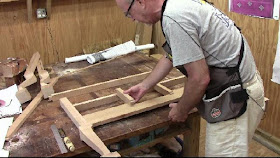The cabriolet legs are still 3 inches square at the top of the leg posts. I have marked out where I want the mortises to be. I am going to make 5/16 mortises 3/4 of an inch deep.
I am using my hollow chisel mortiser which will make quick work out of the task since all of the mortises are the same distance from an edge. The front, sides and back are all 7/8 inches thick.
Here are all the mortises in the legs. Now I have to cut off the excess stock to get to 1 3/4 inches square.
There are many ways to accomplish this, I like to use my bandsaw. It cuts straight after setting it up correctly and the 5/8 inch blade does not leave a very rough finish. Although there is still some clean up.
If you use a table saw be careful to stop before you get to the curved leg. Then finish with a hand saw or bandsaw.
Here are the four legs after they have been trimmed to 1 3/4 square.
These are the drawer dividers for the lower case. The top one is the drawer divider for the large drawer. The lower board is the top rail which holds the case together with a dovetail.
Here I am cutting the dovetail in the rail. This is very typical of 18th century construction to use a dovetail or double tenon on the top rail to help hold the case together.
Here is am using my low angle block plane to remove excess from the tenons on the apron. I always cut them thick so I can fit them tight to the mortises.
Looks like a good tight fit.
Chopping out the matching dovetail opening in the top of the right front post. Very similar to cutting out dovetails on a half blind drawer front.
Tracing the pattern on the front apron.
I cut out an opening for the larger center drawer and then mortised and tenoned columns to separate it from the smaller left and right drawer.
All assembled, the openings are square and the rails are solid.
Next I am going to make the back of the case from pine. I glued up 3 pieces of pine to make
34 7/8 x 17 x 7/8 inch back. After gluing up the panel I am using my crosscut sled to square up the panel.
Here is the front and back dry fitted. Now for the sides.
The sides need to be 17 inches wide with the gain running front to back. I have purchased a matched set of cherry boards which includes one that is 20 inches wide by 14 feet long. I hope to get the lower and upper case sides from this board. I cut 2 pieces from this board for the sides.
Then flattened them with hand planes.
I used a dado set to put a 3/4 x 5/16 tenon all across the sides. Then using my story stick I marked out where the mortises would be and cut the tenons to fit.
You can see the tenons on the side here as I dry fit the sides to the front and back. Nice looking cherry stock. The sides which are one piece will probably crack at some point because the grain is horizontal and the columns have vertical grain. Very common in 18th century furniture.
All done dry fitting the lower case. Next will be to cut out the patterns on the apron and sides. Cut out the corners for the quarter columns. Finish the cabriolet legs and carve the ball and claw feet. That should be in the next video.
Here is today's video:



















No comments:
Post a Comment